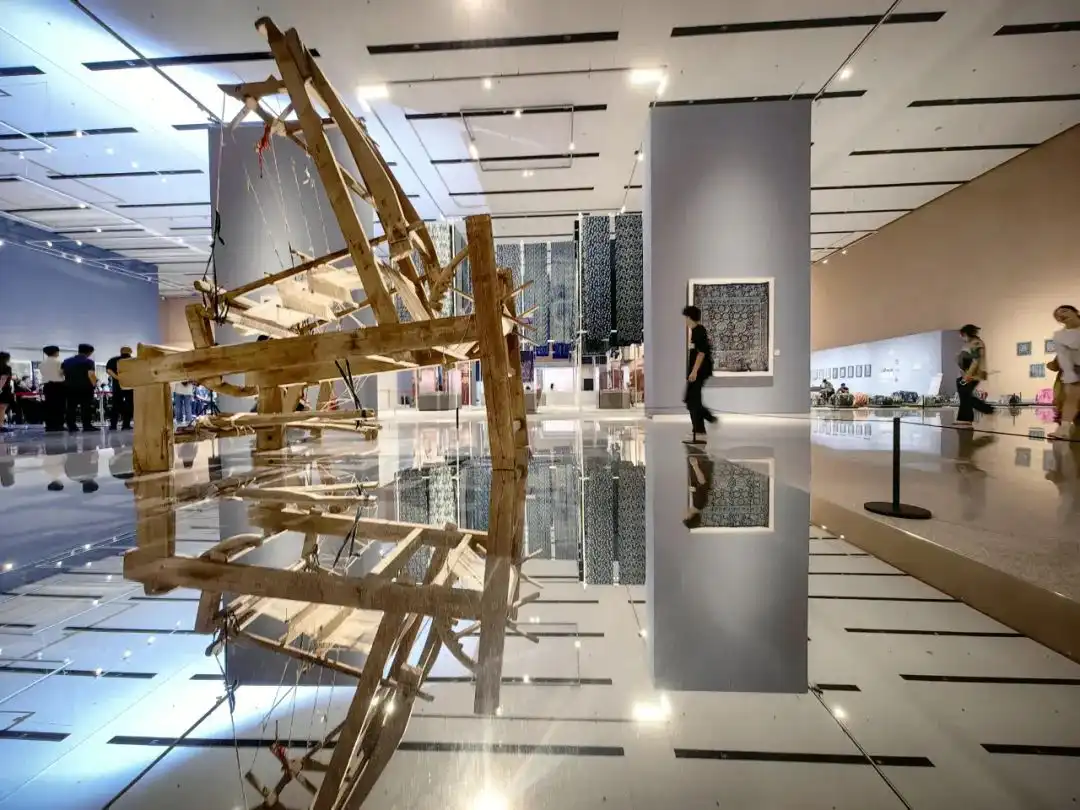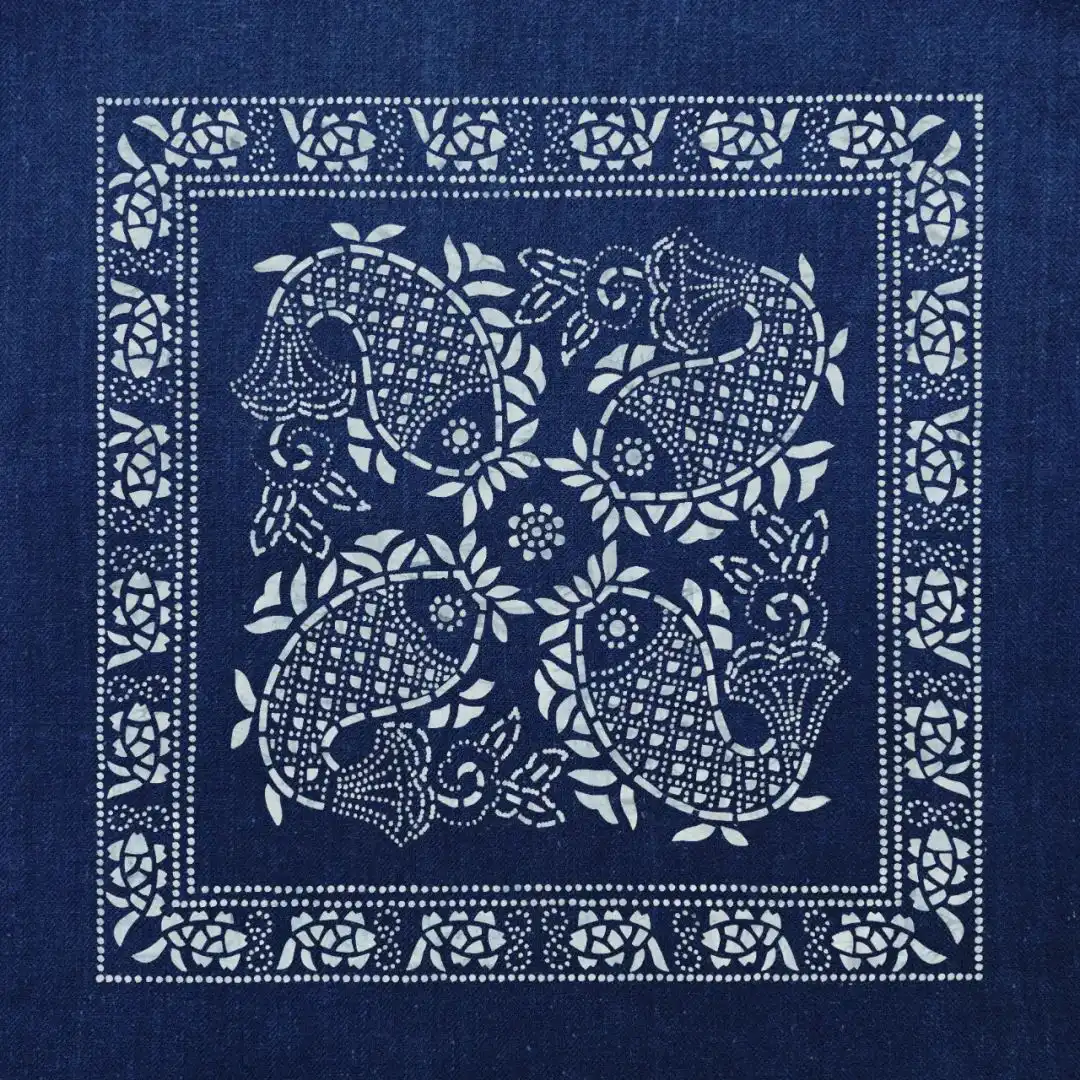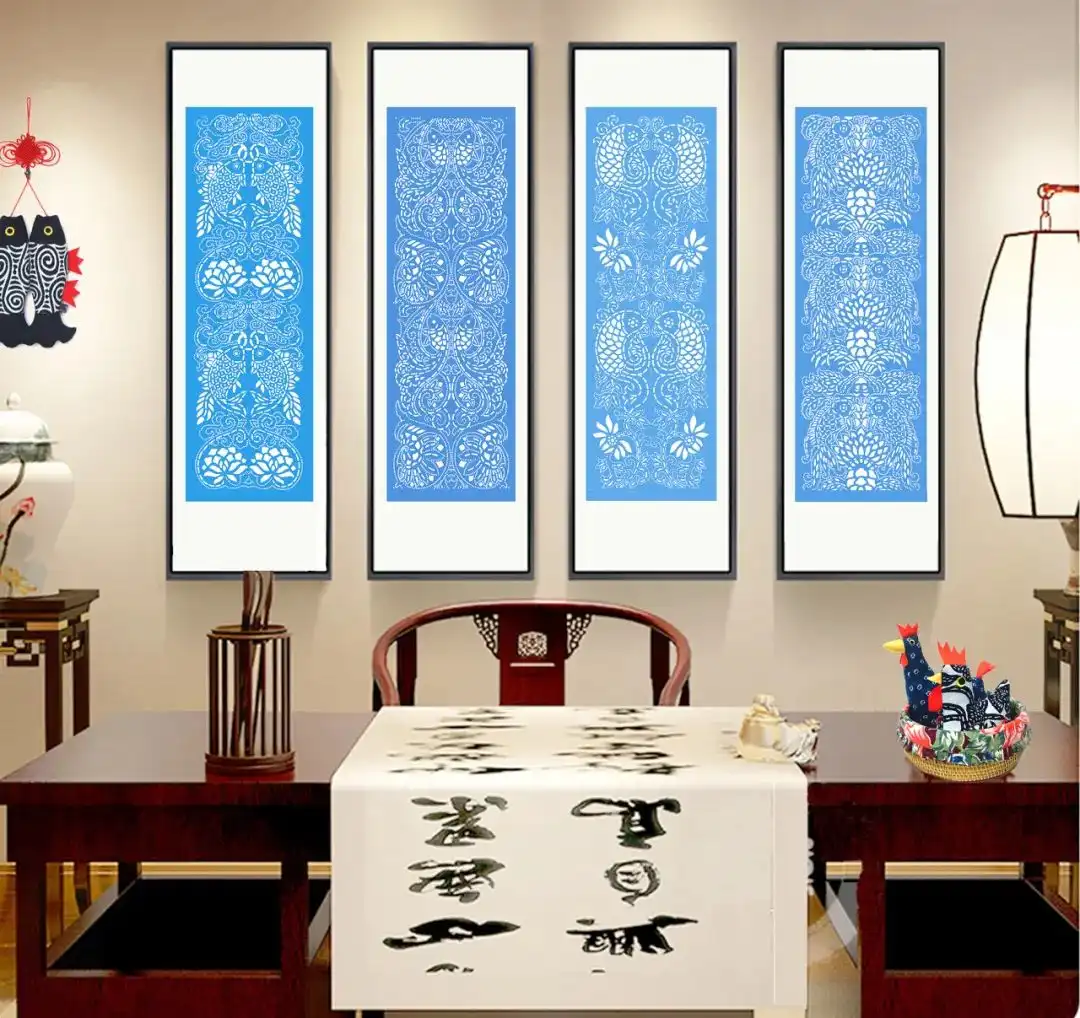Folk treasures:Inheritance and innovation of blue calico
Not long ago, I came to the Feng Jicai Institute of Literature and Art of Tianjin University from Nantong, Jiangsu Province, and invited Mr. Feng Jicai to shoot my documentary "Craftsman".
Twenty years ago, he visited my blue calico museum for the first time and asked me a question:It is difficult for many inheritors of folk crafts to support themselves, let alone create brands, develop products, develop markets, and operate museums. How did you do it?
Perhaps the Nantong Rail Transit Line 2 train that has just been put into operation can represent my state of mind. The body decorated with blue calico patterns designed by my daughter and son-in-law.:"Plum orchids, bamboo and chrysanthemum"-that is tradition;"finless porpoise playing in the water"-represents the present.
我的人生,就好像坐在一趟时代列车上穿行,这趟列车的颜色,是我醉心的蓝白色。Folk treasures
Take a small blue calico and you can open up a corner of Nantong's past.
In their hometown of Qidong City, Jiangsu Province, their ancestors developed farmland, spun and dyed cloth on this coastal land. Having grown up with my mother's spinning and weaving sound, I have vivid and concrete memories of blue calico. At that time, the textiles laid, covered and worn by the local people were made of blue calico. My father's rough printing and dyeing patterns were my first artistic enlightenment. When my grandmother was 88 years old, she could hardly see because of cataracts in her eyes, but she still spun her yarn every day based on her experience. This hard-working and simple spirit and such a strong atmosphere of local craftsmanship have given me an indelible emotion about spinning and printing and dyeing.
In the late 1970s, township enterprises flourished. Because of my interest in blue calico, I chose to work in printing and dyeing at the Huilong Town Printing and Dyeing Factory in Qidong. During the day after day of washing and dyeing cloth, I began to be interested in "engraving" and walked into the engraving studio from time to time to learn a real craft. During those days, I spent all my time on blue calico.
Because of the need for foreign businessmen to order new patterns, I designed patterns and engraved plates in the printing and dyeing factory during the day, and sharpened my painting skills at night, integrating ceramics, wood carving, paper-cutting, embroidery and other elements into the traditional blue calico pattern, and the design style gradually became clearer. Many of the patterns I designed were selected by foreign businessmen and ordered a large number of goods, which gave me great confidence.

On August 22, 2023, the audience visited the "Green Out of Blue·Wu Yuanxin Blue Calico Collection and Design Exhibition" jointly sponsored by the China Art Museum of Arts and Crafts, China Intangible Cultural Heritage Museum, and Nantong Blue Calico Museum at the China Art Museum of Arts and Crafts and China Intangible Cultural Heritage Museum in Beijing. Photo by Xu Congjun (Zhongjing Vision)
In 1989, Yuan Yunfu, then director of the Department of Decorative Arts of the Central Academy of Arts and Crafts (now the Academy of Fine Arts of Tsinghua University), recommended me to study at the Central Academy of Arts and Crafts. In a lecture, when Dean Chang Shana talked about blue calico patterns, many students were very interested. I thought on second thoughts, why not see if blue calico products are popular in institutions of higher learning like the Academy of Fine Arts?
When I returned to school during the holiday, I brought back several large bags of blue calico toys, ornaments and bags I designed and made from my hometown. I asked the school canteen to sell them on my behalf. As a result, they sold out in a week. This attempt surprised me very much and made me realize the domestic market space of blue calico, laying the foundation for me to later build a museum, create a brand, and enter the market.
At that time, Mr. Zhang Ding, the old dean of the Central Academy of Arts and Crafts, told a story:He went to school in Jinzhou City from Montenegro, Liaoning Province. The quilt he brought from his hometown was made of blue calico. Although people in the city laughed at him for being vulgar, he later went to Beijing, Shanghai, and Yan 'an and gave up everything he could. Only the blue calico has been retained, becoming a curtain on Yan' an caves and a decoration in Beijing's home. I told Mr. Zhang Ding that I was engaged in blue calico printing and dyeing in Nantong. He said to me:"Blue calico has a fresh air, a free air, and a prosperous air. It is a treasure of folk art. You must pass it on well."
带着这句话,我学成返乡。"Business" career
At the beginning of 1996, my unit was merged due to declining efficiency, and the blue calico project was cancelled.
I can't give up! I want to establish a blue calico art museum to display the fine blue calico I have collected and designed over the years and continue my blue calico career. Therefore, when textile museums in Nantong had to rely on rental houses to maintain their operations, I started the preparation of the Blue Calico Art Museum and started a "business" career.
At that time, every weekend, my wife and I would take blue calico works with two large woven bags to the Shanghai distribution point to sell them, and take a boat back to Nantong at 10 p.m. In order to save money, I only buy fifth-class tickets and find a place to rest in corridors, escalators, and bottom cabins. After returning to Nantong, I continued to design and produce the blue calico works to be sold next week without daring to delay for a moment.
In October 1996, I rented the house of Nantong Textile Museum and erected the plaque of "Nantong Blue Calico Art Museum" beside the Haohe River. Since then, this place has become my blue and white world. Many older visitors looked at the blue calico products displayed in the museum and recalled the beautiful memories of their fathers wearing blue calico and covered with blue calico quilts; young visitors were attracted by the innovative products of this art museum, simplicity and "modernity" meet magically here.

The blue calico pattern designed by Wu Yuanxin. (Data picture)
During the day, I receive visitors in the museum, make blue calico crafts and introduce the inheritance history of blue calico; at night, I return to the workshop to design patterns, study techniques, and organize materials. Every once in a while, I still bring designed blue calico crafts to Shanghai for sale to supplement the operating capital of the art museum.
After several years of hard work, the art museum has overcome the difficulties at the beginning, achieved a virtuous cycle of the capital chain, and gradually formed an intangible cultural heritage museum operation model integrating collection, research, display, production, and inheritance, which continues to this day.
In 2004, Mr. Feng Jicai came to the Blue Calico Museum for an inspection. He saw a large number of ancient blue calico works displayed in the museum and flipped through stacks of heavy manuscripts that I was going to publish. He was quite surprised. I told him that on the basis of inheriting the traditional excellent blue calico patterns and skills, I constantly innovatively launched works that meet the needs of modern people, sold them in large cities and exported them abroad, and used these income to collect blue calico., protection, research and display and product innovation.
In 2006, the "Nantong Blue Calico Printing and Dyeing Skills" that I was responsible for applying for was included in the first batch of national intangible cultural heritage. I have also been among the first batch of representative inheritors of national intangible cultural heritage.
Over the past few decades, I have traveled to 1378 towns and villages using blue calico in 22 provinces including Jiangsu, Zhejiang, Hunan, Hubei, Shandong, Shanxi, and Beijing, and tried my best to find the remains of blue calico. At present, Nantong Blue Calico Museum has rescued and protected as many as 68230 traditional printing and dyeing objects such as blue calico, sandwiched calico, twisted calico, wax calico, and folk color printing since the Ming and Qing Dynasties, and sorted out 200,000 patterns. These remains of blue calico, which carry the simple emotions of the working people, are the root and soul of innovation.
The things of our ancestors must not only be collected and studied, but also innovated while studying. The single-sided printing process has been innovated into double-sided printing, narrow cloth printing and dyeing has been developed into wide-width printing, monochrome printing and dyeing has been innovated into deep and light blue multi-color printing, and single cotton varieties have been expanded to silk, cashmere, cotton and linen, etc. The five major series of blue calico works we have innovatively developed, including clothing, bags, wall hanging, handicrafts, and shoes and hats, which are integrated into people's daily lives with their simple beauty and trendy creativity.
embrace the market
In the process of "rescuing" and "protecting", collecting blue calico lost to the people, I really understood these two words.
The inheritance of a traditional craft cannot be supplemented by young people, and every traditional craft must achieve something, which takes at least 10 or even 20 years. Therefore, few young people are willing to adhere to these "slow-heating" cultures.
My daughter Wu Lingshu studied art design at the China Academy of Art and wanted to stay in a big city to develop after graduation. I thought, if my daughter is unwilling to come back and inherit blue calico, who else will be willing to inherit and protect this ancient skill with me? At first, her daughter didn't understand, but in the end, she returned home to become a young inheritor of blue calico.
Dyeing cloth is an austere and a physical job. My daughter is single and weak, and it is very difficult to undertake the tasks of dyeing, picking cloth and other tasks of printing and dyeing. My son-in-law Ni Shenjian quit his job in the bank and also entered my traditional dyeing workshop. The addition of a new generation of young people has given blue calico products in the new era more creativity.
In the creation, we absorbed the printing and dyeing skills of traditional folk red calico, and red-embellished children's clothes cheongsam and vests were released. My daughter suggested that free breaking of the knife should reflect the modern sense and give traditional patterns a fashionable atmosphere. My family and I also used the traditional texture on blue calico to design the Hundred Phoenix Picture, Hundred Fish Picture and Hundred Butterfly Picture, which can be used as wall hanging or made into various decorations.
Over the years, I have trained more than 400 young talents in traditional printing and dyeing skills at Nantong University, and have also opened courses at Tsinghua University, Central Academy of Fine Arts, Tianjin University, Soochow University and other universities. Family inheritance, college inheritance, apprentice inheritance... batches of young inheritors of blue calico skills came to the stage.
I still remember when the "Blue Art" brand was first launched more than 20 years ago, I selected the Pisces pattern from the backpack skin and made it a three-dimensional Chinese knot. The wings were red and the eyes were yellow. It looked beautiful and auspicious when hanging at home. In those years, people could often see this work when traveling to Tongli and Wuzhen, and it won the gold medal in the first China Tourism Souvenir Design Competition in 2002.

The decorative wall hanging renderings of "There is Fish Every Year" designed and produced by Wu Yuanxin, Wu Lingshu and Ni Shenjian. (Data picture)
In 2016, I registered the "Yuanxin Blue" brand and co-operated it with the original "Blue Art" series of handicrafts. At first, I didn't have the confidence to name it after my own name. Is it appropriate? At that time, a senior in the cultural world told me that you are a national master of arts and crafts. Traditional intangible cultural heritage should have your own resounding brand and use the best ideas to launch warm and emotional works.
"Blue Art" didn't sound well after 20 years of use, but "Yuanxin Blue" started sounding well after less than 8 years of use. We took the opportunity to launch the cloth dyeing brand "Dyesu", which mainly sells small handkerchiefs, small pendants and small wallets, forming our own brand matrix.
Today, blue and white have been integrated into my life and have become the main colors of life that cannot be erased. I believe that in the near future, blue calico, a flower of folk art, will bloom even more brilliantly.
